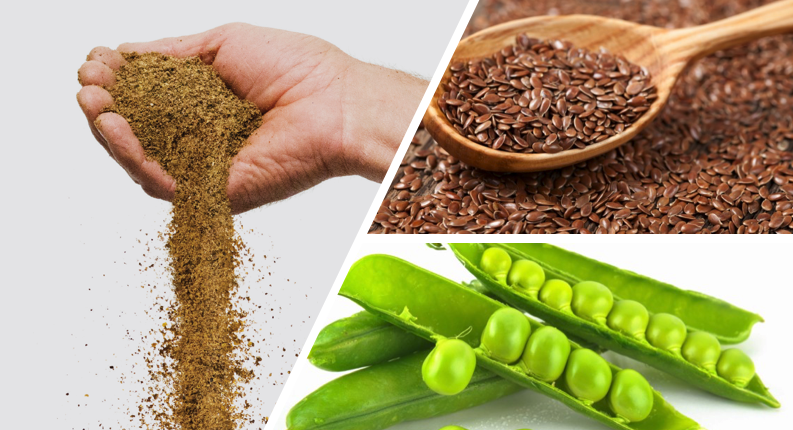How It’s Made: The Power of Dry Extrusion~LinPRO Edition!
Welcome to O&T Farms Featured Newsletter: The Naturally Better News by O&T Farms

At O&T Farms, we use the term “dry extrusion” when describing how our value-add linPRO products are manufactured; but what does the term really mean? Simply put, extrusion is a process in which material is pushed through a small opening; however, it’s important to know that not all extrusion processing is the same. O&T Farms patented dry extrusion process helps increase the functional usage of raw ingredients while also providing added availability of nutrients to the livestock.
1. Defining Dry Extrusion:
Dry extrusion is a unique form of extrusion processing in that no external heat source is used during the cooking of the product. Instead, dry extrusion relies solely on the heat generated from the friction of the material as it passes through the barrel by a screw. A common misconception of the term “dry extrusion” is that the process occurs in the absence of moisture; however, moisture of the raw ingredients entering the dry extruders may range from 8-22% and can be modified through pre-conditioning processes. In contrast, “wet extrusion” processes may apply an external heat source directly into the barrel during cooking (e.g. steam).
2. Impact on Nutritional Value of Feed
Proteins:
During the cooking-phase of dry extrusion processing, the proteins of the raw ingredients begin to denature. The approach applied by O&T Farms ensures temperatures reach the necessary level to break the secondary bonds of protein molecules releasing individual amino acids and improving their availability for digestion by the animal. The process reduces the solubility of the protein which is of special significance for ruminant livestock as it improves the level of rumen undegradable protein (RUP) while ensuring the digestibility of the amino acids in the lower GI-tract.
Starch:
Starch represents a significant portion of the total energy value of any feed ingredient and gelatinized starch is much more efficient for the animal to digest. As raw feed ingredients pass from the extruder barrel and are pushed through the narrow die opening of the extruder unit, the sudden release of pressure facilitates expansion. This expansion process ruptures the starch cell walls, vaporizes moisture and opens the starch molecule up making it more accessible to digestive enzymes.
Fat:
Fat from flaxseed is the not-so-secret ingredient in LinPRO products and offers an important value-add opportunity for the North American oilseed industry since whole oilseeds are difficult for livestock to digest and utilize efficiently. Milling of flaxseed has been applied for livestock feed but only partially disrupts the durable seed-coats and increases the risk of fatty acid oxidation.
Under the O&T Farms patented dry extrusion process, carefully calibrated conditions are applied to improve the nutrient availability of the oils in flaxseed while also improving the overall stability and shelf-life of the product. By matching the flaxseed with a specific starch source and combining them through their processing parameters, the formation of lipid-starch complexes can be facilitated which makes the finished product less soluble and more stable. It is this reaction that necessitates the use of acid hydrolysis analysis when determining the fat content of an extruded product, since some of the fat will not be soluble in the commonly used ether extract methods. This reaction also has particular implications for dairy cattle as it can help reduce the risk of milk-fat depression and impaired fibre digestibility by reducing lipolysis and subsequent biohydrogenation of unsaturated fats within the rumen.
Anti-nutritional Factors:
Many feed ingredients contain compounds known as anti-nutritional factors which reduce the efficiency of nutrient utilization by the animal. Dry extrusion processing has consistently demonstrated an ability to reduce and inactivate commercially-significant anti-nutritional factors such as urease and trypsin inhibitor. By reducing the presence of these compounds in the feed, livestock can use the nutrients more efficiently which increases the overall nutritional value of the product.
Feed Safety:
More than ever, feed safety is top-of-mind for livestock producers and feed manufacturers. The cooking process through dry extrusion is an excellent strategy for reducing the microbial-load of feed ingredients and minimizing the risk of feed contamination.
3. The Take-away
Extrusion is an efficient technology that is used to breakdown raw ingredients into a homogenized, cooked, easily digestibly and stable product. However, not all extruded products are the same in that the application of this technology is highly variable throughout the feed manufacturing industry resulting in different physical quality and nutritional characteristics of the end product. O&T Farms applies a unique and well defined patented dry extrusion method in the manufacturing of their LinPRO products through carefully calculated processing conditions to optimize nutritional value of the finished livestock feed ingredient.





